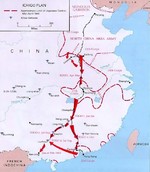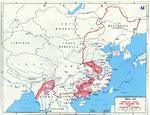![Ichigo file photo [13192] Ichigo file photo [13192]](/images/battle_ichigo4.jpg)
Operation Ichigo
Contributor: C. Peter Chen
ww2dbaseOn 19 Apr 1944 the Japanese forces launched Operation Ichigo with 400,000 men organized in 17 divisions, supported by 12,000 vehicles and 70,000 horses. The operation had three major objectives:
- Control the entire length of the railroad between Beiping and Hong Kong
- Link up the forces in China and those in French Indochina
- Control Allied air fields in southern China
ww2dbaseAdditionally, the Japanese troops were told to destroy crops and other food supplies whenever the opportunities arose as an attempt to further worsen the Nationalist Chinese food situation.
ww2dbaseBattle of Henan
13 Apr-25 May 1944
ww2dbaseThe initial phase of Ichigo saw the Japanese 12th Corps troops moving south from Kaifeng and the 11th Corps northward from Hankou of Wuhan. After several engagements near Xuchang, Luoyang was attacked on 13 May. The three divisions defending Luoyang under the command of Tang Enbo was defeated on 25 May. All of Henan Province was taken by the end of the month.
ww2dbaseFourth Battle of Changsha
Jun-Aug 1944
ww2dbaseIn the first week of Jun, Japanese forces marched southward along the railroad toward Changsha and engaged at the Hunan Province city for the fourth time in the Second Sino-Japanese War. With 360,000 in ground troops alone, this attack was the largest during the entire war with China. With overwhelming force, the previously stalwart defenders of Changsha faltered, and the city was taken by the Japanese. Nearby, the city of Hengyang and the nearby airfield held against the initial assault. In Aug, the second attack against Hengyang commenced with the Japanese 11th Division taking heavy casualties from well-laid Chinese defensive emplacements. The 58th Division, however, was able to breach the Chinese defense and enter the city. The Chinese attempted to send in reinforcements, but the attacking Japanese forces prevented the reinforcements from reaching their comrades now trapped in the city. Hengyang was taken after a total of 47 days of fighting with heavy tolls on the Japanese, who had suffered over 900 officer casualties, including 390 deaths.
ww2dbaseIn addition to the loss of the airfield at Hengyang, another at Lingling, also in Hunan Province, was captured by the Japanese during this campaign.
ww2dbaseThis engagement was also known as Battle of Hengyang-Changsha.
ww2dbaseBattle of Battle of Guilin-Liuzhou
1 Nov-11 Nov 1944
ww2dbaseStarting on 16 Aug 1944, the Japanese 11th and 23rd Armies began to move into the northeastern region of the Guangxi Province. The total of 120,000 Chinese troops fought an effective delay action campaign that did not allow the 150,000 Japanese troops to reach Guilin (Kweilin) and Liuzhou until 1 Nov. Guilin and Liuzhou were defended largely by troops who had recently retreated from the Fourth Battle of Changsha, therefore not only under-strength but also morale-broken. The 20,000 Chinese troops there managed to hold on to the two cities for ten days before retreating. Two-thirds of Guangxi fell under Japanese control by the end of the month, along with all the Allied airfields in the region. Nanning, the capital of Guangxi, fell in Dec. The Chinese suffered 100,000 casualties in Guangxi between Aug and Dec 1944, while the Japanese suffered 60,000.
ww2dbaseThe Japanese units involved in this battle were accused of conducting a reprisal operation against Chinese civilians that left over 200,000 dead.
ww2dbaseThis was the second fall of Guangxi, with the first being in Nov-Dec 1939. With Japanese troops occupying Guangxi, Japanese movement between northeast China (Manchukuo) and Indochina was opened. However, at this stage of the war, the actual practical gains from it were minimal. In fact, the troops required to occupy Guangxi probably cost the Japanese war effort more than what was gained, for that the troops could had been used elsewhere in the Pacific. The Japanese Navy, however, was relieved somewhat as the opening of land supply routes meant they were no longer required to perform logistical duties.
ww2dbaseConclusion of the Campaign
ww2dbaseAlthough the Japanese achieved nominal victory all across the board with Operation Ichigo, strategically the effect was marginal. The Allied air forces, consisted mainly of the US 14th Air Force, simply moved to airfields further inland and continued their operations from there. The threat of American B-29 bombers in China on the Japanese home islands was indeed eliminated by taking the airfields, but it was only temporary; by early 1945, the bombers were transferred to the new airfields in the Marianas and attacked Japan from there. Nevertheless, General Joseph Stilwell was relieved in Oct 1944 by Franklin Roosevelt after Chiang Kaishek's complaints that the burden of the losses during Ichigo fell on Stilwell's shoulders. Stilwell's role of Chief of Staff and Commander of the US Forces, China Theater (USFCT) was replaced by Major General Albert Wedemeyer; his other command responsibilities in the China-Burma-India Theater were divided up and allocated to other officers. If the Americans were to blame for the defeat, the reason was probably not Stilwell alone. The "Europe First" strategy employed by Allied leaders rendered the China-Burma-India Theater an after-thought, and whatever supplies trickled into the region were bitterly fought over between Stilwell and Claire Chennault. Therefore, the recall of Stilwell was largely a political move to please Chiang.
ww2dbaseSources: U.S. Army Center of Military History, Wikipedia.
Last Major Update: Oct 2006
Photographs
 |
Maps
 |  |
Operation Ichigo Timeline
| 8 Apr 1944 | Japanese aircraft conducted raids across Henan Province, China. |
| 19 Apr 1944 | In order to forestall the bombing of the homeland by American B-29 bombers from bases at Guilin and Liuzhou in China and to seize the Beiping-Hong Kong railroad, Field Marshal Shunroku Hata, Commander-in-Chief of the Japanese Army China Expeditionary Force launched the Ichi-Go (Number one) offensive with a force of some 620,000 men, which was the largest force ever assembled by Japan for a single campaign. The main thrust was a powerful drive southwards from Hankou by the 11th Army, designed to link up with a push westward by 23rd Army from Guangdong. |
| 22 Apr 1944 | Japanese troops captured Zhengzhou, Henan Province, China. |
| 13 May 1944 | Japanese troops attacked Luoyang, China. |
| 25 May 1944 | Japanese troops captured Luoyang, China. |
| 18 Jun 1944 | In China, the strategic city of Changsha, 200 miles south of Hankou, fell to the Japanese, having successfully defied them three times before. |
| 26 Jun 1944 | Japanese troops reached Hengyang, Hunan Province, China, site of an important US air base, but were checked by the 15,000-strong Chinese 10th Army supported by US 14th Air Force's B-25 Mitchell and P-47 Thunderbolt aircraft which made constant attacks on the Japanese supply lines. |
| 16 Aug 1944 | Japanese troops entered northeastern Guangxi Province, China. |
| 14 Sep 1944 | Joseph Stilwell visited Guilin, China and ordered the nearby airfields to be abandoned and gas stores destroyed to prevent Japanese capture. |
| 1 Nov 1944 | Japanese troops reached Guilin, China. |
| 8 Dec 1944 | Japanese troops captured Tushan, Jiangsu Province, China. |
Please consider supporting us on Patreon. Even $1 per month will go a long way! Thank you. Please help us spread the word: Stay updated with WW2DB: |
Visitor Submitted Comments
22 Jan 2012 07:11:32 AM
dear mr chen, first let me thankyou for the work you are doing. second, do you have or can you tell me where i can get any information about the us army personnel assigned to the zebra force. my reason for asking is because my dad was an adviser and trainer to the chinese nationalist soldiers who were supposed to defend the air base in hengyang. unfortunately he was killed by the japanese while he and several others were attempting to escape from hengyang in june of 1944. i read a lot about the 14th air force and their roll in the war, but practically nothing about the roll of the men in the z-force. again, it is most unfortunate that his military records were destroyed in the 1973 fire at the records center. i am trying to learn more about his duties and responsibilities. any information you can provide would be greatly appreciated. thanking you in advance
11 Sep 2014 05:13:59 PM
My cousin was in the co-pilots seat of the C-39 that was carrying Doolittle's homing beacons, which crashed . He is 97 years old but I am trying to piece together the whole story....
2 Apr 2021 10:41:59 AM
Dad John P. Humphries at Yangkai 44’ to 45’ B 25’s Radio/gunner 491st Ringers’! Thanks Dad and Buds
5 Jun 2021 06:06:02 PM
@
My Great Grandfather was the Engineering Commander during the Heng-yang airfield retreat. I have some photos of his maybe your father is in it?Shoot me an email ordo101@gmail.com
All visitor submitted comments are opinions of those making the submissions and do not reflect views of WW2DB.
» Jiang, Dingwen
» Okamura, Yasuji
» Sun, Du
» Tang, Enbo
» Xue, Yue
» Zhang, Lingfu
Location:
» China
Notable Aircraft:
» Ki-43 Hayabusa
» P-40 Warhawk
- » 1,165 biographies
- » 337 events
- » 44,601 timeline entries
- » 1,243 ships
- » 350 aircraft models
- » 207 vehicle models
- » 376 weapon models
- » 123 historical documents
- » 261 facilities
- » 470 book reviews
- » 28,615 photos
- » 429 maps
Winston Churchill, on the RAF
18 Jul 2007 12:00:33 PM
i visit Zhaoqing -near guilin . i wonder if Zhaoqing involved ,cant find ww2 facts regarding zhaoqing -locals tell me of airraids -but say no i.j.a occupation ,id like to know more ,can you help regards brian stone